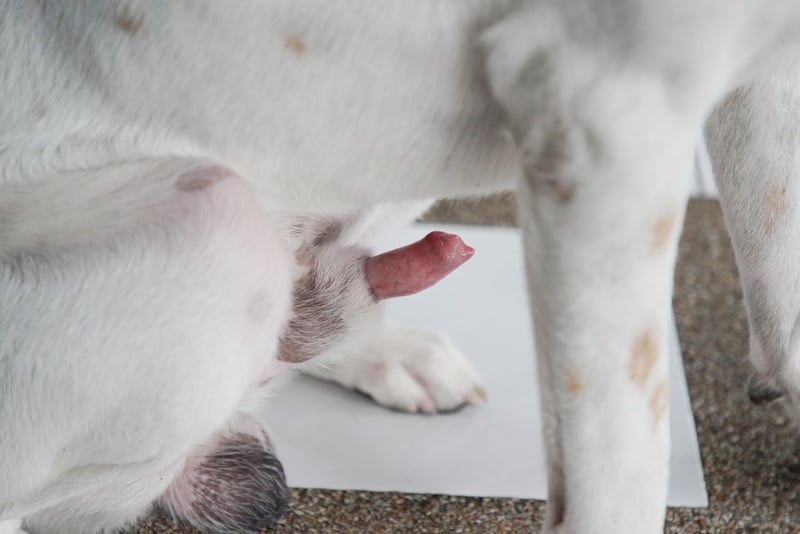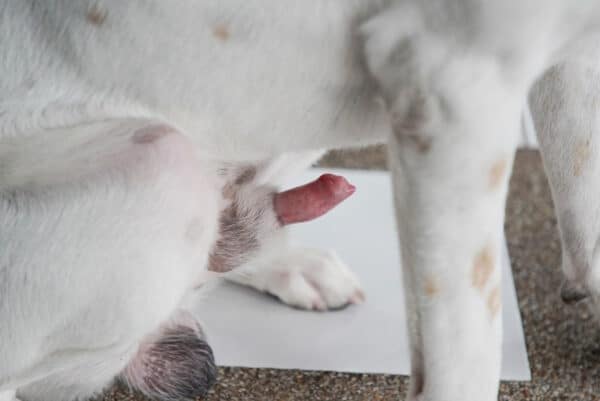Dog owners will be familiar with many of the weird and wonderful things our pets do. One of these is having their “lipstick” out. This is when their penis sticks out of its sheath. Dogs experience erections frequently; they can occur when they are sexually aroused, excited, nervous, or if they are having a particularly good belly rub.
It is perfectly normal for dogs to get erections. Problems arise when the penis stays out of the sheath for prolonged amounts of time. If the dog is unable to completely reduce the penis back into the preputial cavity, this is called paraphimosis. If the penis is outside the body for a long time, it can become engorged to the point where it is unable to go back inside.
If this happens it is a medical emergency, and you need to speak to your vet. Read on to learn everything you need to know about paraphimosis and what to do if this happens to your dog.
What Is Paraphimosis in Dogs?
Paraphimosis is a phenomenon that occurs when your dog cannot retract their penis back into the sheath of skin that usually sits around it. This sheath is called the prepuce. The skin around the top of the sheath becomes inverted and traps the penis. Blood is prevented from draining back down so the penis becomes red and swollen very quickly. It usually becomes a problem when the penis has been trapped in this position for over 30 minutes.
The outside of the penis is made of sensitive mucosa that is not meant to be exposed to the outside for long periods. It very quickly begins to dry out and become inflamed and very painful. Dogs can often panic and start to lick the tissue. This causes even more irritation and inflammation.
If you are in a situation where you have noticed your dog’s penis sticking out, you will need to take your dog to your vet. In the meantime, you can attempt to gently wash the area with warm water if your dog will tolerate it. Paraphimosis is a painful medical emergency. If you think your dog may have paraphimosis, you need to contact your vet immediately.
Paraphimosis is not to be confused with priapism. This occurs when the penis maintains an erection in the absence of stimulation. This is usually due to a neurological problem.

What Are the Signs of Paraphimosis in Dogs?
It can be difficult to see the penis in some dogs, depending on their hair length and if they are overweight. If you can see your dog’s penis, you will be able to monitor for any clinical signs. Common ones include:
- Engorged red penis visibly swollen
- Licking of the penis and surrounding area
- Discharge from the penis
- Difficulty passing urine or leaking urine
- Edema in the surrounding tissues near to the penis
What Are the Causes of Paraphimosis in Dogs?
The most common cause of paraphimosis in dogs is excessive licking of their penis. It can be chronic low-frequency licking or sudden onset high-frequency. Different things will trigger different dogs. If your dog likes to hump a lot when they get sexually excited, this can also cause paraphimosis.
Anatomical features can predispose your dog to paraphimosis. If there is a small preputial opening of the sheath, or if the edges of the sheath roll inwards, this can contribute to the development of the condition. If there are foreign bodies near the penis that become trapped this can also cause problems.
Injury or trauma can cause paraphimosis as well. It is important to let your vet know if your dog has experienced any trauma as there may be damage to the surrounding tissues as well. Dogs have a bone in their penis that can become fractured. This is extremely painful.
Neurological issues such as herniated discs and disorders affecting muscles can also cause the problem. As can cancer and infections.
Paraphimosis is often seen in dogs that have had an erection due to the manual collection of semen for artificial insemination purposes. If a dog has been mated naturally, it is less likely that they will experience paraphimosis.
Whatever the cause may be, once the penis is out of the sheath, and unable to return, the skin at the preputial orifice starts to invert. This traps the penis outside of the body with a tourniquet effect. The dog’s penis then swells dramatically. Due to the swelling, venous drainage is delayed, and this exacerbates the situation.
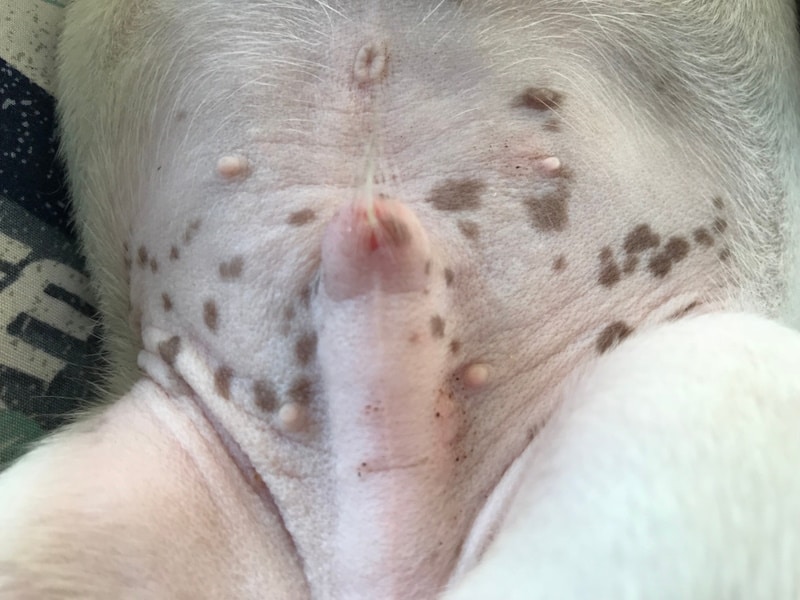
Diagnosis of Paraphimosis in Dogs
Diagnosis of paraphimosis is usually based on clinical signs and history. Your vet will examine your dog and, in most cases, it is obvious as the penis can be clearly seen as it will be red and engorged.
Further testing will be required if your dog is displaying any other clinical signs of being unwell. Blood tests and urinalysis can be very useful. If a tumor is suspected, tissue biopsies may need to be taken. Your vet may also want an X-ray to search for a fracture. Ultrasound scans may also be of use.
How Do I Care for a Dog With Paraphimosis?
The key to treating paraphimosis is to act fast. The sooner the problem is identified, the easier it is to replace the penis. The longer it is out of the sheath, the more swollen and painful it gets.
If paraphimosis has recently occurred and there is little or no swelling, a pet-safe lubricant can be rubbed on the penis, and gentle pressure can be used to push the penis back into its sheath.
If the paraphimosis has been present for a longer amount of time and has started to swell, your vet may need to sedate your dog and give pain relief before attempting to replace the penis. The penis will need to be cleaned, as well as the surrounding areas. Any hair will be clipped away. Lubricant will be applied, and then gentle pressure used to push it back into the correct position in the sheath. A cold compress or a sugar solution to draw out the fluid can also be used to attempt to reduce the swelling.
In severe cases, your dog may have to be put under a general anesthetic to attempt to get the penis back into the sheath. If the penis keeps moving out of the sheath, it may be necessary to put a suture around the top of the skin to keep it inside. Your vet will check that the urethra has not been damaged; if this is the case, a urinary catheter will need to be placed until the urethra heals.
If there are any tumors present, they may be removed depending on whether your vet can operate on them. If your dog has an anatomical defect, your vet can correct this by performing reconstructive surgery. For example, if the preputial opening is small, your vet can open it up to prevent the penis from getting stuck out in the future. In very severe cases where the penis becomes strangulated, it may be necessary to perform a partial penile amputation to remove devitalized tissue.
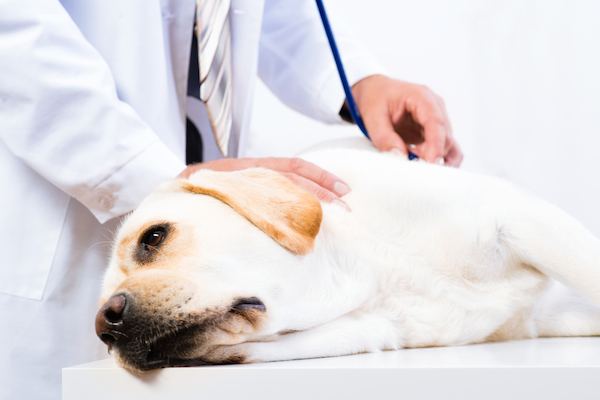
Frequently Asked Questions (FAQ)
When should I take my dog to the vet for paraphimosis?
If you notice your dog’s penis has been out of their body for longer than 20 minutes, this is a cause for concern.
If the penis has changed color or your dog is showing any other signs of illness or distress, contact your vet immediately. If it is a recurring problem and it has occurred again, you will also need to go straight to your vet.
Can paraphimosis be a recurring issue?
Yes, paraphimosis can be a recurring issue. Certain situations can trigger episodes such as semen collection for artificial insemination. Certain breeds of dogs can be predisposed due to anatomical issues. Dogs that lick their penis and the surrounding area are also more likely to experience issues.
Is there any way to prevent paraphimosis?
It is not possible to completely prevent paraphimosis. However, you can reduce the risk of it occurring by having your dog neutered. It may also help to keep the hair near the opening of the sheath trimmed short to keep this area clear and clean. Always make sure your dog’s genitals are clean. If you are going to breed, use a dog-safe lubricant and clean your dog’s penis and the surrounding area after semen collection or breeding.
Keep a close eye on your dog, especially if you know that they are prone to this problem.
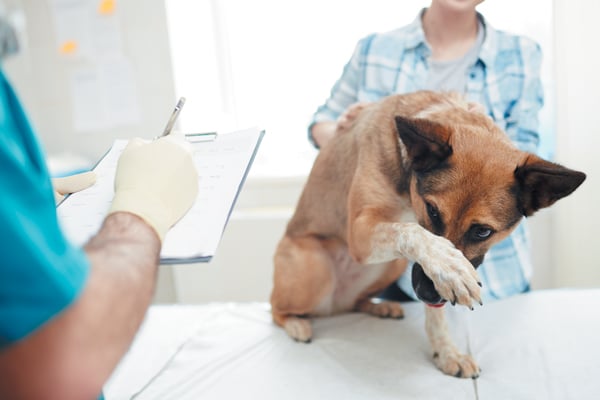
Conclusion
Paraphimosis in dogs is a painful condition that can have serious consequences if left untreated. The prognosis is good if caught early, before too much swelling has occurred. It can affect any male dog, but breeding stud dogs are commonly affected.
It is not recommended to try and treat this problem at home. Even if you do manage to replace your dog’s penis, it is always best to get them checked out by your vet as there could be an underlying disease causing the paraphimosis that requires further treatment.
Featured Image Credit: charnsitr, Shutterstock
Contents
- What Is Paraphimosis in Dogs?
- What Are the Signs of Paraphimosis in Dogs?
- What Are the Causes of Paraphimosis in Dogs?
- Diagnosis of Paraphimosis in Dogs
- How Do I Care for a Dog With Paraphimosis?
- Frequently Asked Questions (FAQ)
- When should I take my dog to the vet for paraphimosis?
- Can paraphimosis be a recurring issue?
- Is there any way to prevent paraphimosis?
- Conclusion

